Huge cracks in ceiling, who to call?
Discussion
I have huge cracks in the ceiling both upstairs and down and also in the plaster on the walls, it only seems to be internally with nothing showing outside. The house is 130 years old so there have always been the odd crack which needs filling when we decorate but nothing like these. What specialist do I need to call to take a look and see if we have issues with subsidence? Or do I just call my insurance and ask them to send someone?
Are you saying new cracks have appeared?
Out of nowhere?
OR has something caused this like building work?
Personally I would be calling a mate who is a builder who understands old houses.
You probably need to to talk to your insurance company if you are concerned or don't understand what's going on.
It's hard to tell over the interweb, more so without pictures, but you might even need to be calling your mates looking for somewhere safe to stay.
Out of nowhere?
OR has something caused this like building work?
Personally I would be calling a mate who is a builder who understands old houses.
You probably need to to talk to your insurance company if you are concerned or don't understand what's going on.
It's hard to tell over the interweb, more so without pictures, but you might even need to be calling your mates looking for somewhere safe to stay.
We've had an extremely dry period so it's not altogether surprising that new cracks are appearing, I know we've got plenty in our 1911 house.
If you're worried, mark them and see if they grow/widen. Maybe share some photos on an old house group on Facebook. Consult a builder who understands old houses.
I definitely wouldn't involve insurance initially as it'll just cost you money on the long run over something that could be nothing.
If you're worried, mark them and see if they grow/widen. Maybe share some photos on an old house group on Facebook. Consult a builder who understands old houses.
I definitely wouldn't involve insurance initially as it'll just cost you money on the long run over something that could be nothing.
Going through this at the moment, get onto your insurance if you are worried, it’ll take them a few weeks to get someone out.
Measure the cracks, sub 2mm is ‘ok’ in that no immediate danger (as such)
Place some tape across the cracks, mark each side to monitor any significant movement, crude but visual
Take plenty of photos
Any issue with any windows / doors?
Check inside / outside, other potentially impacted rooms
Ours appeared essentially overnight, up to 2mm, inside, outside, upstairs and downstairs!
Huge increase in subsidence issues according to my insurance company, pretty sure ours has been caused by dry weather, clay drying out and the fruit trees nearby the house, fingers crossed they accept the claim!
Good luck, as I say insurance took a while to get someone out, I spoke with them the first day the cracks appeared, you don’t want to leave it 6/12 months, they get worse and you’ve not told them.
Measure the cracks, sub 2mm is ‘ok’ in that no immediate danger (as such)
Place some tape across the cracks, mark each side to monitor any significant movement, crude but visual
Take plenty of photos
Any issue with any windows / doors?
Check inside / outside, other potentially impacted rooms
Ours appeared essentially overnight, up to 2mm, inside, outside, upstairs and downstairs!
Huge increase in subsidence issues according to my insurance company, pretty sure ours has been caused by dry weather, clay drying out and the fruit trees nearby the house, fingers crossed they accept the claim!
Good luck, as I say insurance took a while to get someone out, I spoke with them the first day the cracks appeared, you don’t want to leave it 6/12 months, they get worse and you’ve not told them.
4Q said:
1st and 3rd pics are upstairs, the other 2 are downstairs directly underneath
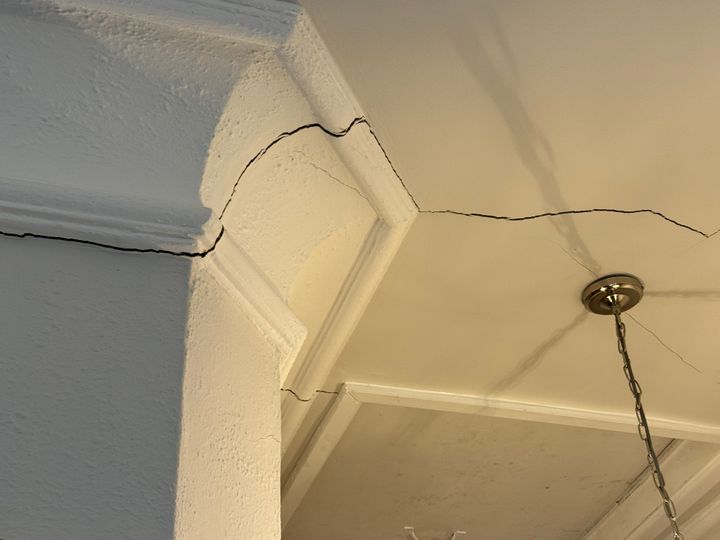
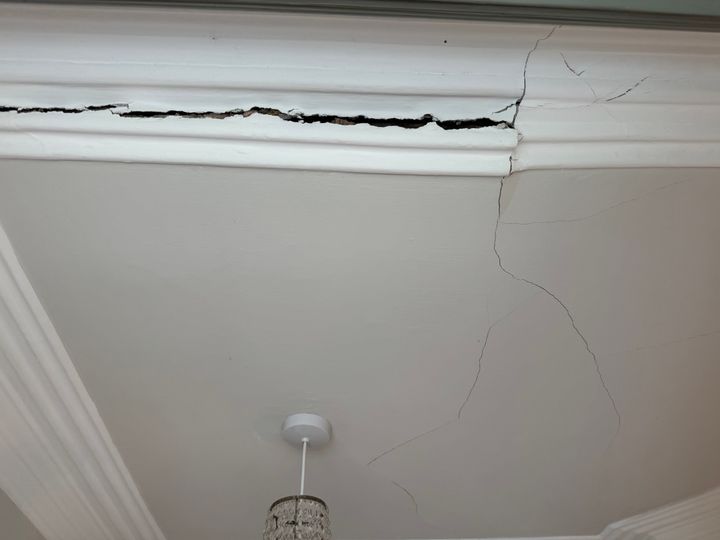
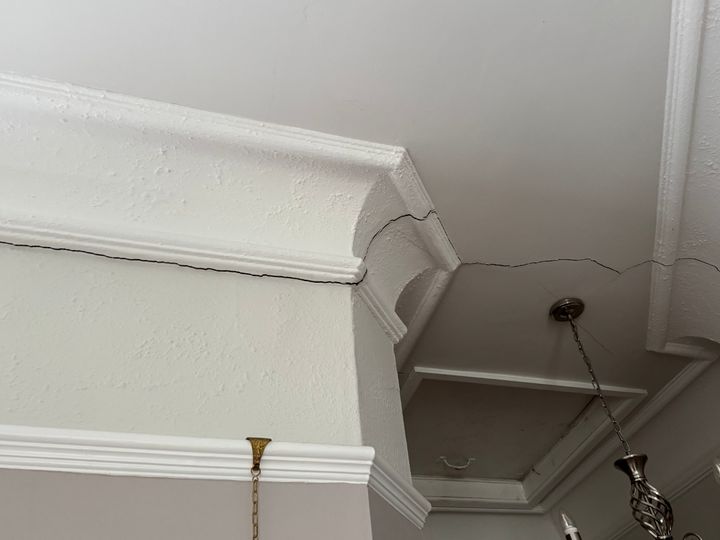
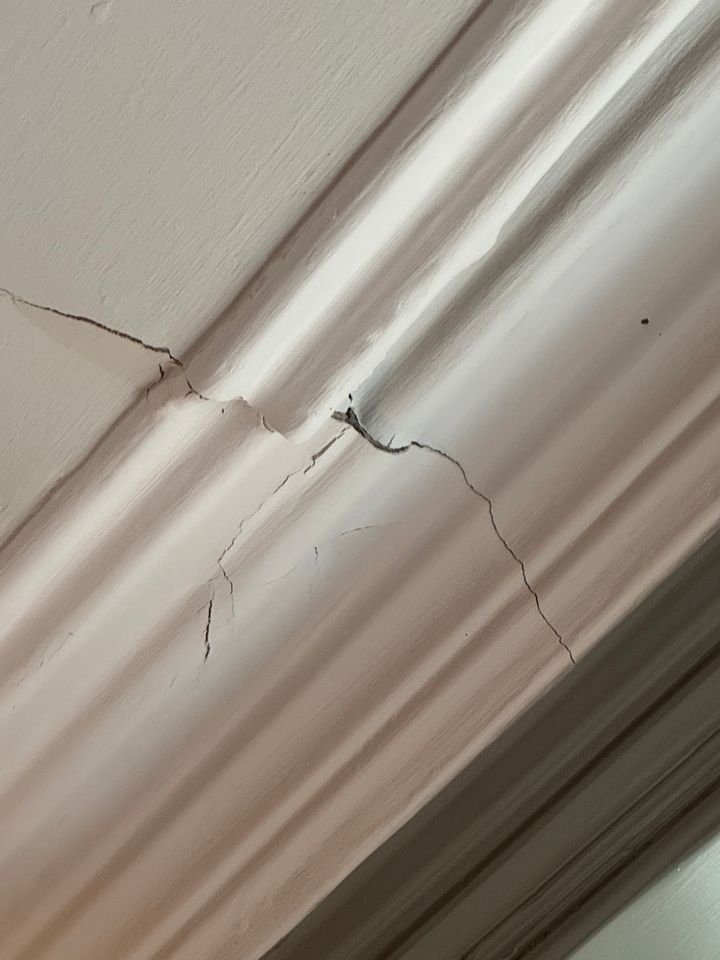
None of those are structural wall cracks, it's all ceilings and solid plaster coving and that stuff is always on borrowed time when it's that vintage.Edited by 4Q on Saturday 30th August 15:37
Bit of extra shrinkage in the timber in the summer will do that in a more modern house too, though that tends to just crack board boundaries & coving while the old heavy solid stuff just detaches and lands on your head.
Our house is a converted stable house, originally built in 1848.
I am not sure whether I was fobbed off, but we had an original ceiling collapse in an upstairs bedroom with my then 4 year old lad in there. Luckily he was not hurt. We were told it was wear and tear and so insurance were not interested.
As there was no assignable cause (leaking pipe, subsidence, etc.) - this gave the adjudication that it was wear wmd tear. No cracks were seen, just one windy night.
I am not sure whether I was fobbed off, but we had an original ceiling collapse in an upstairs bedroom with my then 4 year old lad in there. Luckily he was not hurt. We were told it was wear and tear and so insurance were not interested.
As there was no assignable cause (leaking pipe, subsidence, etc.) - this gave the adjudication that it was wear wmd tear. No cracks were seen, just one windy night.
mike9009 said:
I am not sure whether I was fobbed off, but we had an original ceiling collapse in an upstairs bedroom with my then 4 year old lad in there. Luckily he was not hurt. We were told it was wear and tear and so insurance were not interested.
As there was no assignable cause (leaking pipe, subsidence, etc.) - this gave the adjudication that it was wear wmd tear. No cracks were seen, just one windy night.
It's what these things do. They detach gradually, then all at once.As there was no assignable cause (leaking pipe, subsidence, etc.) - this gave the adjudication that it was wear wmd tear. No cracks were seen, just one windy night.
By the time you can see it sagging and cracking it's already too late. Not that you can do much preventative in the first place short of early demolition & replacement.
JoshSm said:
None of those are structural wall cracks, it's all ceilings and solid plaster coving and that stuff is always on borrowed time when it's that vintage.
Bit of extra shrinkage in the timber in the summer will do that in a more modern house too, though that tends to just crack board boundaries & coving while the old heavy solid stuff just detaches and lands on your head.
Under an upstairs window Bit of extra shrinkage in the timber in the summer will do that in a more modern house too, though that tends to just crack board boundaries & coving while the old heavy solid stuff just detaches and lands on your head.
If was just on one floor I would have put it down to age but the fact that it’s on both floors is what concerns me
How quickly has all this happened?
Yes plaster cracks, and sometimes bits fall off old ceilings.
But when lots of cracks appear at the same time, I'd suspect a common cause.
Like a wall moving or something.
It hasn't all sat there happily for decades then coincidentally all decided to crack at the same time.
It may not be a huge problem, but a lump of plaster falling off an old fashioned plaster and lath ceiling can hurt, possibly do significant injury.
It's not a risk I'd subject family to.
Also, if bits start falling off, the dust is going to be unpleasant and possibly harmful.
If you start giving it a prod to see how bad it is, it could get very messy, very quickly.
Try not to slam the door on your way out!
4Q said:
Under an upstairs window
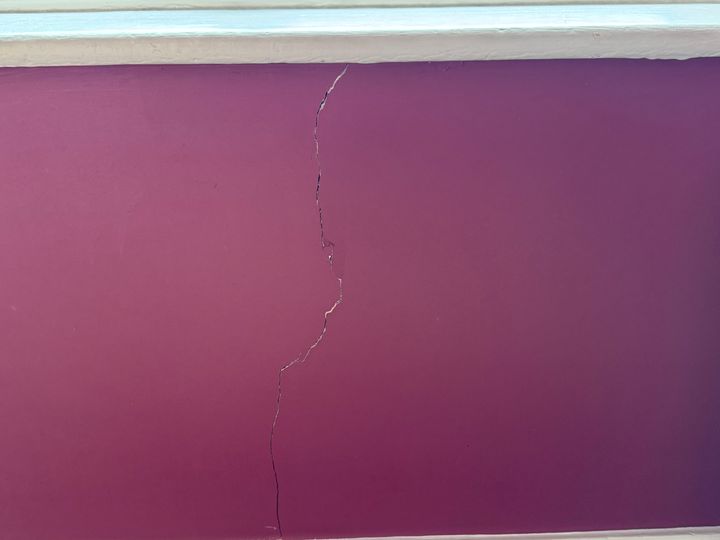
If was just on one floor I would have put it down to age but the fact that it’s on both floors is what concerns me
Anything on the outside or is it just in the plaster? Could still be shrinkage rather than any settlement or movement.If was just on one floor I would have put it down to age but the fact that it’s on both floors is what concerns me
Ceilings are the big concern as those look like they've failed.
Are you on a clay soil?
Are there big trees around outside?
Those factors, combined with this year's very dry weather, could easily be trying to demolish your house. I'd start by contacting a surveyor and then, depending on what he says, insurers. I wouldn't contact insurer's first; they have an awkward habit of getting jumpy.
Are there big trees around outside?
Those factors, combined with this year's very dry weather, could easily be trying to demolish your house. I'd start by contacting a surveyor and then, depending on what he says, insurers. I wouldn't contact insurer's first; they have an awkward habit of getting jumpy.
There have always been the odd cracks in the plaster but nothing this serious. They have opened significantly over the last few days and the ceiling downstairs has cracked and sagged by 10mm today and looks ready to fall. What kind of surveyor do I need?
Not sure if we are on clay soil but we do have a number of mature trees 5m or so from the house
Not sure if we are on clay soil but we do have a number of mature trees 5m or so from the house
Edited by 4Q on Saturday 30th August 17:44
If the cracks are all in the same section or sections that are stacked above each other, my instinct is subsidence. As others have said, the long hot spells recently have shrunken clay in a lot of areas, which could be a cause of this kind of ground movement. The other possibility that enters my head is, do you live near any old mines? The recent heavy downpours over the last couple of days have been enough that i wouldn't be surprised to see it cause a sinkhole to open up.
Easy to speculate on causes.
Comes down to some sort of ground movement or failure of some component of the house.
A mate had a farmhouse where a big wooden beam was a bit rotten at one end, so it didn't get much support from the wall any more.
I've seen old buildings where the walls have spread so eventually a joist comes out of the wall.
Dodgy repairs and modifications can take years to come to light.
You may not know the truth of it without some dismantling.
It's an awful thing to happen, but thus far, nobody is hurt, I assume it's insured, it can be mended or replaced.
Comes down to some sort of ground movement or failure of some component of the house.
A mate had a farmhouse where a big wooden beam was a bit rotten at one end, so it didn't get much support from the wall any more.
I've seen old buildings where the walls have spread so eventually a joist comes out of the wall.
Dodgy repairs and modifications can take years to come to light.
You may not know the truth of it without some dismantling.
It's an awful thing to happen, but thus far, nobody is hurt, I assume it's insured, it can be mended or replaced.
Gassing Station | Homes, Gardens and DIY | Top of Page | What's New | My Stuff



